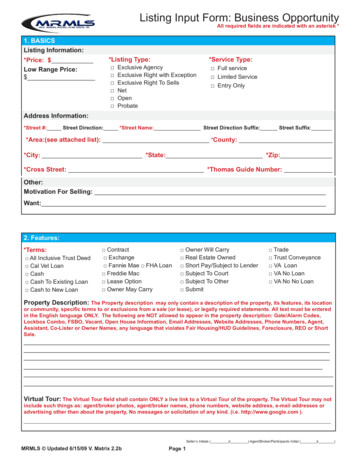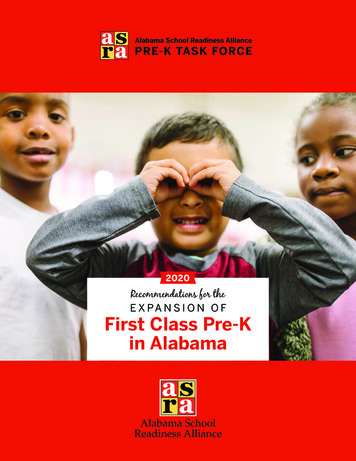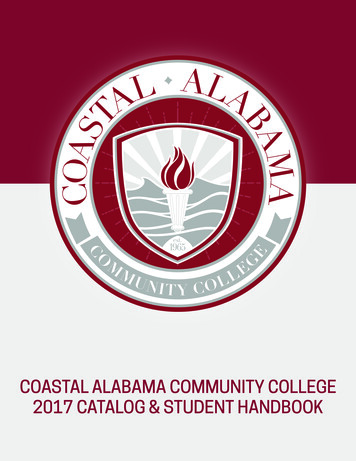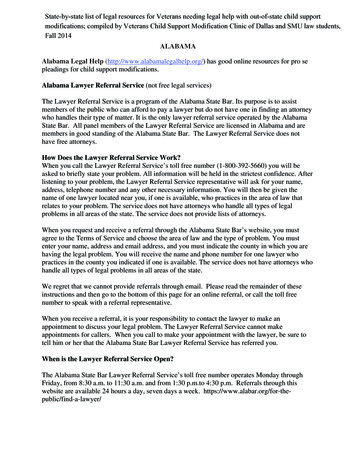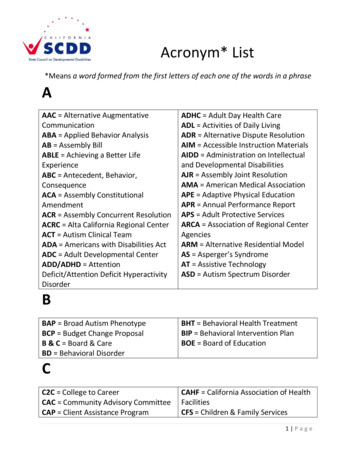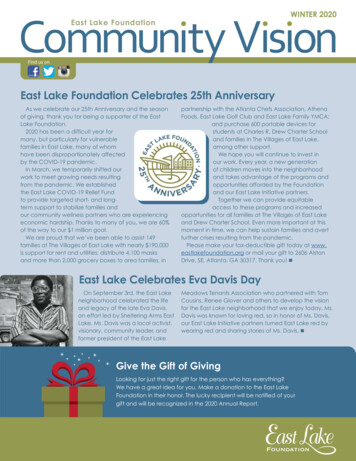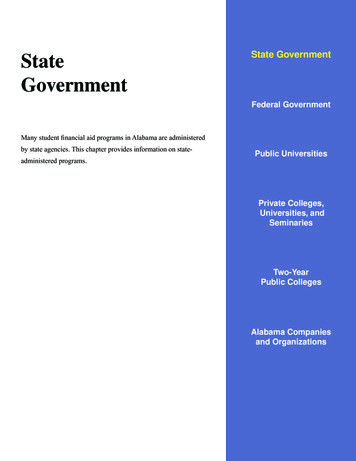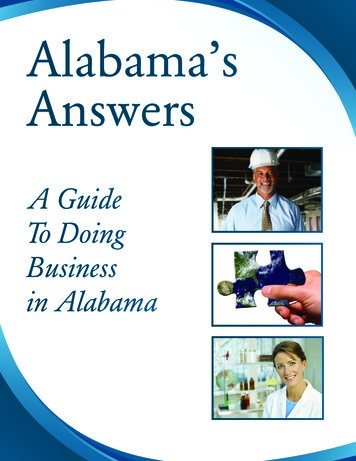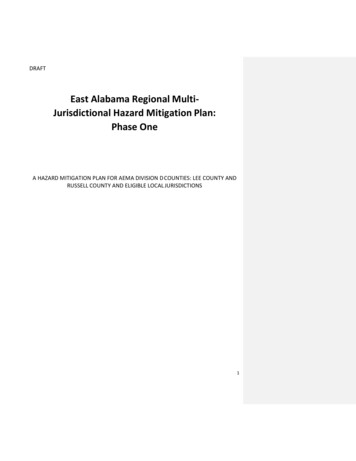
Transcription
DRAFTEast Alabama Regional MultiJurisdictional Hazard Mitigation Plan:Phase OneA HAZARD MITIGATION PLAN FOR AEMA DIVISION D COUNTIES: LEE COUNTY ANDRUSSELL COUNTY AND ELIGIBLE LOCAL JURISDICTIONS1
DRAFTTABLE OF CONTENTSSection 1Section 2Hazard Mitigation Plan Introduction1.1Plan Scope1.21.31.4AuthorityFundingPurposeLee – Russell Regional Profile2.12.22.32.42.5Section 3Planning Process3.13.23.33.43.5Section 4Hazard OverviewHazard ProfilesTechnological and Human-Caused HazardsVulnerability OverviewProbability of Future Occurrence and Loss EstimationTotal Population and Property Value Summary by JurisdictionCritical Facilities/Infrastructure by JurisdictionHazard ImpactsVulnerable Populations in Lee-Russell Planning AreaMitigation5.15.25.35.45.5Section 6Multi-Jurisdictional Plan AdoptionMulti-Jurisdictional Planning ParticipationHazard Mitigation Planning ProcessPublic and Other Stakeholder InvolvementIntegration with Existing PlansRisk Assessment4.14.24.34.44.54.64.74.84.9Section 5BackgroundDemographicsBusiness and IndustryInfrastructureLand Use and Development TrendsMitigation Planning ProcessRegional Mitigation GoalsRegional Mitigation StrategiesCapabilities Assessment for Local JurisdictionsJurisdictional Mitigation Action Plans5.5.1 Lee County Jurisdictions Actions5.5.2 Russell County Jurisdictions ActionsPlan Maintenance Process2
DRAFT6.16.26.3Section 7Hazard Mitigation Monitoring, Evaluation, and Update ProcessHazard Mitigation Plan IncorporationPublic Awareness/ParticipationAppendix7.1Appendix A: Community Survey7.2Appendix B: Agendas7.3Appendix C: Briefs, Advertisements, and Sign-in Sheets7.4Appendix D: Hazard Events Tables3
DRAFTSection 1 - Hazard Mitigation Plan IntroductionSection Contents1.11.21.31.4Plan ScopeAuthorityFundingPurpose4
DRAFT1.1Plan ScopeThe East Alabama Regional Multi-Jurisdictional Hazard Mitigation Plan is a plan that details the multitudeof hazards that affect the Alabama Emergency Management Agency (AEMA) Division D area. This regionincludes Autauga, Bullock, Chambers, Chilton, Coosa, Elmore, Lee, Lowndes, Macon, Montgomery, Russelland Tallapoosa counties and the municipalities, as well as other jurisdictions, within these counties. Thefirst phase (version) of this plan covers Lee and Russell counties. The remaining counties will be insertedin future updates. This plan fulfills the requirements set forth by the Disaster Mitigation Act of 2000 (DMA2000). DMA 2000 requires counties to formulate a hazard mitigation plan in order to be eligible formitigation grants made available by the Federal Emergency Management Agency (FEMA).Each of the twelve counties in AEMA Division D has an existing multi-jurisdictional hazard mitigation plan.This plan will compile information from each of those existing plans and documents the incorporation ofhazard mitigation objectives into the region, as a whole. The AEMA Division D has a diversity of economicaland physical development, but many of the hazards affecting the region have similar impacts throughoutthe area. A regional hazard mitigation plan is able to encapsulate these similarities in risk and vulnerabilityimpact, with regional stakeholders being able to discuss mitigation techniques for these similar impacts.1.2AuthoritySection 409 of the Robert T. Stafford Disaster Relief and Emergency Assistance Act (public Law 93-228, asamended), Title 44 Code of Federal Regulations, as amended by Part 201 of the Disaster Mitigation Act of2000 requires that all state and local governments develop a hazard mitigation plan as a condition ofreceiving federal disaster assistance. These plans should be approved by FEMA and updated every fiveyears.1.3FundingFunding for the East Alabama Regional Multi-Jurisdictional Hazard Mitigation Plan was made availablethrough the Hazard Mitigation Grant Program (HMGP), under Disaster Recovery Declaration 1971 (DR1971). Supplemental funding was supplied by the county commissions of Lee and Russell counties, and theLee-Russell Council of Governments.1.4PurposeThe East Alabama Regional Multi-Jurisdictional Hazard Mitigation Plan is an effort to evaluate and identifyall prioritized hazards which may affect AEMA Division D. It presents mitigation strategies that address thehazards identified. This plan is only one of many steps jurisdictions in East Alabama will take to protect thewelfare of residents by achieving a safer environment for its residents.5
DRAFTSection 2 - Regional ProfileSection ess and IndustryInfrastructureLand Use and Development Trends6
DRAFT2.1BackgroundThe planning area is defined by Alabama Emergency Management Agency (AEMA) as DivisionD, which is one of seven emergency management divisions within the state. AEMA Division Dis located in eastern Alabama (Figure 2.1). AEMA Division D is comprised of the followingtwelve counties: Autauga, Bullock, Chambers, Chilton, Coosa, Elmore, Lee, Lowndes, Macon,Montgomery, Russell, Tallapoosa and the jurisdictions in those counties. This version of themulti-jurisdictional hazard mitigation plan covers two of the twelve AEMA Division D countiesand the jurisdictions in Lee and Russell Counties. The additional ten counties and thejurisdictions in the AEMA Division D are currently covered by their own hazard mitigation planbut will be fully included in subsequent update(s). Information for Lee and Russell County arethe only counties included. Please refer to Figure below to see where in Alabama Division D islocated.7
DRAFTLee and Russell counties are located in East Central Alabama along the Chattahoochee River,which is the western boundary of the State of Georgia. Lee County occupies 608 of the 50,744square miles of Alabama, while Russell County occupies 647 acres. The following Tablepresents the land area of each county and that of its municipalities.Table 2.1 Total Area by CountyJurisdictionTotal AreaLee County (entire)City of AuburnTown of LoachapokaCity of OpelikaCity of Smiths StationUnincorporated CountyRussell County (entire)Town of HurtsboroCity of Phenix CityUnincorporated County60859.3751.18596.59481.855647124622Source: United States Census Bureau, Total AreaLee County and the northern portion of Russell County is part of the Piedmont Plateau, largelycharacterized by hilly topography with gentle to steep slopes. The terrain in the southernportion of Russell County is largely level to gently rolling, as it is located in the Coastal Plain.The soil varies from rocky, red clay in the north to a sand clay mixture in the center and amore sand soil in the south.The Chattahoochee River borders Lee and Russell counties on the east, forming the borderbetween the State of Alabama and the State of Georgia. There are many large creeks in LeeCounty including Holland Creek, Mill Creek, Pepperall Creek, Rocky Creek, Saugahatchee Creekand Town Creek. The main creeks in Russell County include Uchee Creek, Little Uchee Cree,Halawakee Creek and Wachoochee Creek.8
DRAFT9
DRAFT10
DRAFT2.2DemographicsAccording to the 2010 Census, the combined population of the Lee-Russell region was 193,194persons. The following table provides the 2010 population according to the US Census Bureau aswell as the latest estimates for each jurisdiction. As evidenced in Table 2.2, the Lee-Russellcounty region is experiencing population growth.Table 2.2: Jurisdiction PopulationJurisdiction2010 CensusPopulation2018 CensusEstimate% ChangeLee 5%11.11%15.40%10.17%9.13%6.55%11.00%City of AuburnTown of LoachapokaCity of OpelikaCity of Smiths StationRussell CountyTown of HurtsboroCity of Phenix CitySource: United States Census Bureau (2010 Census and 2018 Population Estimates)Based on the 2010 Census, the median age for residents within this region ranges from 23.3 yearsof age in Auburn to 47 years of age in Loachapocka. Much of the lower median age in Auburn canbe attributed to Auburn University. Racial and ethnic characteristics from 2010 by county arepresented below in Table 2.3:Table 2.3: Racial and Ethnic Demographics by CountyCountyLee CountyRussell CountyWhite%71.3%53.7%Black %22.741.8%Other %4.0%2.9%Hispanic % (*)3.33.7%Source: United States Census Bureau, 2010 Census(*Hispanic Population may be of any race)According to the U.S. Census Bureau’s 2013-2017 ACS 5-Year Population Estimate, there are 89, 257 totalhousing units in the Lee-Russell region. Housing information estimates, including more vulnerable housingsuch as mobile homes and aging housing, are presented by county in Table 2.4 below:Table 2.4: Housing Conditions by CountyCountyOccupied HousingUnitsLee County59,001Russell County22,690Mobile Homes, (%)Housing 38 Years, (%)9,622; (16.3%)3,419; (15.06%)16,613; (28.2%)10,091; (44.5%)Source: U.S. Census Bureau (2013-2017 ACS 5-Year Estimates)Unemployment rates for the Lee-Russell region are represented in the following Table 2.5:11
DRAFTTable 2.5: Average Unemployment Rate by CountyCountyUnemployment Rate (Jan-Sept. 2019)Lee County3.0%Russell County3.2%Source: Alabama Department of Labor (2019)Based on the U.S. Census Bureau’s 2013-2017 ACS 5-Year Population Estimate, Lee County has a total of59,001 households and Russell County has 22,690 households. The U.S. Census Bureau defines a“household” to include all people who occupy one unit of residence, such as an apartment, single room,mobile home, or a house. Table 2.6 represents the median income for the Lee-Russell region:Table 2.6: Household Median Income by CountyCountyLee CountyRussell CountyIncome 47,564 38,988Source: U.S. Census Bureau (2013-2017 ACS 5-Year Estimates)The U.S. Census Bureau determines poverty based on the poverty threshold. If the total income is greaterthan the poverty threshold, then the family or person is not considered in below the poverty line. The U.S.Census Bureau uses the following two equations to determine poverty status: Income / Threshold X orIncome – Threshold X. Table 2.7 displays the total number of an individual below the poverty line and thepercent below the poverty line.Table 2.7: Individuals below the Poverty Line by CountyCountyIndividuals Below Poverty LineLee County33,132Russell County12,024% Below Poverty Line22%20.9%Source: U.S. Census Bureau (2013-2017 ACS 5-Year Estimates)According to the U.S. Census Bureau’s 2013-2017 ACS 5-Year Population Estimate there are 92,452 personsin Lee County and 38,710 persons in Russell County 25 years or older. Table 2.8 shows the total numberand rate for highest education attained (high school graduate or less) of person 25 and older.Table 2.8: Highest Education Attained (High school Graduate or Less) by CountyCountyIndividuals (25 ) with High% of Individuals (25 ) with HighSchool Graduate or LessSchool Graduate or LessLee County31,96334.6%Russell County19,15449.5%Source: U.S. Census Bureau (2013-2017 ACS 5-Year Estimates)Based on the U.S. Census Bureau’s 2010 Census there were 5,189 (Lee County) and 2,905 (Russell County)persons 75 years or older. The 2013-2017 ACS 5-Year Population Estimate reported 7,321 (Lee County) and3,281 (Russell County) persons 75 years or older. From 2010 to 2018 in Lee County there was a 41.09%increase in the population of 75 years or older, and a 12.94% increase in Russell County. The large increasein the persons 75 years or older can be attributed to the large Baby Boomer population reaching 75 yearsold.12
DRAFTTable 2.9 represents the number of people 75 years or older in 2010 and 2018County2010Lee County5,189Russell County2,90520187,3213,281Source: U.S. Census Bureau (2010 Census and 2018 Population Estimates)13
DRAFT14
DRAFT15
DRAFT2.3Business and IndustryThe Lee-Russell region supports a wide variety of industrial and commercial stakeholders. Thearea is home to a large, widely diverse economic base, with automotive, aviation, medical, andother manufacturing and high tech industry. The region is also home to a world class whitewatercourse on the Chattahoochee River as well as being home to Auburn University, the state’soriginal land grant university is located in Lee County.Table 2.10: Major Employers (Over 400 employees)EmployerAuburn UniversityEast Alabama MedicalCenterLee County SchoolsAuburn City SchoolsPhenix City Board ofEducationWestRockWalmart DistributionCenterAlaTrade Foods, LLCCity of AuburnOpelika City SchoolsAfni, IncBriggs & Stratton Corp.Mando America Corp.Russell Co. Board ofEducationCSP TechnologiesNorth America, LLCCountyLeeLeeProductLand-Grant Public Research UniversityRegional EducationEducation1,2601,010983RussellLeeKraft Container BoardGrocery Distribution Center870825RussellLeeLeeLeeLeeLeeRussellFood ProcessingLocal GovernmentEducationCall CenterGasoline EnginesAutomotive – Brakes, SteeringEducation800725590540505499445LeeSpecialty Plastics Packaging400Source: Economic Development Partnership of Alabama, Local Economic Development ContactThe individual industries are susceptible to the same natural hazards as the remainder of theregion, i.e., high wind events, tornadoes, flooding, etc. The economic impact of losing anyindustry is directly related to the size/type of business and the duration/severity of the loss.2.4InfrastructureTransportationThe region is bisected by Interstate 85 and lies midway between the capital cities of both Alabamaand Georgia. Atlanta, Georgia is one hour northeast and Montgomery, Alabama is one hour tothe west. I-85 is the main transportation corridor between the Port of Mobile and the east coast.The region is also convenient to Birmingham, the largest metropolitan area in Alabama, andColumbus, Georgia to include the Fort Benning Military Installation. Major highways that are16
DRAFTlocated in the region are U.S. Highway 280, 29 and 431. There are no commercial airports in theregion; residents must drive to Columbus, GA, Montgomery, AL, Atlanta, GA or Birmingham, AL.The Robert J. Pitts airport in Auburn provides services to private planes and corporate jets. Raillines serving the region include Norfolk Southern and CSX Transportation.UtilitiesElectrical service in the Lee and Russell County region is provided by Alabama Power, TallapoosaRiver Electric Cooperative, Opelika Power and Light and Dixie Electric Cooperative. Natural Gasservice is provided by the Alabama Gas Corporation.Water and sewer service is provided by a mixture of municipal and county utility authorities.Most populated areas have public water service; however, most unincorporated areas rely onseptic systems for sewer disposal.2.5Land Use and Development TrendsThe Lee-Russell Region is semi-rural predominantly composed of evergreen forest, deciduousforest, pasture, and urban areas. Lee County has a larger urban footprint than Russell County dueto the size of Auburn and Opelika. Russell county is completely rural expect for Phenix City. Thelargest urban area in the Lee-Russell Region is Auburn with the population of 65,738, whichcontinues to be a fast growing metropolitan area in the East Central portion of Alabama. Auburnis the economic driver for the region due to Auburn University, which is the largest employer inthe region.Based on the data collected from the U.S. Census Bureau the EMA Division D area grew by 14.76%from 2010 to 2018. The largest growth from 2010 to 2018 occurred in Auburn (23.15%), Opelika(15.40%), and Phenix City (11.11%). These areas continued to expand their urban footprint. As thepopulation in these areas continues to grow the so does the vulnerability o natural hazards. Anincrease in population increases the vulnerability a population has towards natural hazards aswell as the opportunity to damage or destroy the newly built urban environment associated withgrowth.Every community in the region, particularly the fast growing areas, should work towards buildingin compatible areas that are not susceptible hazards such as flooding and other location-specifichazards in their long-range development plans in order to make communities more resilient tohazards.17
DRAFT18
DRAFTSection 3 – Planning ProcessThe Planning Process section of the Plan addresses requirements of Section 201.6(c)(1) throughproviding the planning process used to develop the plan, including how it was prepared, who wasinvolved in the process and how the public was involved.Section Contents3.13.23.33.43.5Multi-Jurisdictional Plan AdoptionMulti-Jurisdictional Plan ParticipationHazard Mitigation Planning ProcessPublic and Other Stakeholder InvolvementIntegration with Existing Plans19
DRAFT3.1Multi-Jurisdictional Plan AdoptionEach participating jurisdiction will adopt the plan when it is deemed “approvable pendingadoption” by the Federal Emergency Management Agency (FEMA). Eligible jurisdictions includeregional planning councils and local governing bodies, including municipal councils, countycommissions and local school districts.3.2Multi-Jurisdictional Planning ParticipationEach eligible local jurisdiction in Lee and Russell counties provided participation in thedevelopment of this regional hazard mitigation plan. Local jurisdictions within the regionparticipated according to the standards set forth by the Regional Hazard Mitigation PlanningCommittee.The remaining counties in AEMA Division D will be fully integrated within the regional hazardmitigation plan in a phased process. The first phase includes Lee and Russell counties. Thesecond phase will include Autauga, Elmore and Montgomery counties and the third phase willinclude Tallapoosa, Lowndes, Macon, Chilton, Coosa, Chambers and Bullock counties. At theconclusion of the phased process, there will be a regional AEMA Division D Hazard Mitigation Planwith the same deadline/update cycle.3.3Hazard Mitigation Planning ProcessThe AEMA Division D Multi-Jurisdictional Hazard Mitigation Plan has been developed throughinteraction between AEMA Division D EMA Directors, the AEMA Division D Coordinator and theLee-Russell Council of Governments, which comprised the Division D Core Team.Members of the AEMA Division D Core Team developed county-level planning subcommitteesprimarily based on past Hazard Mitigation Plan update participants and the Local EmergencyPlanning Committees. The review of previous local hazard mitigation plans and development ofthe requirements for participating within the regional planning process was developed by theDivision D Core Team.Each jurisdiction is expected to participate in the planning update process by: Attend scheduled meetings, or if unable to attend, send a designee or make themselvesavailable to discuss the agenda through phone conversation, email or in-person meeting. Represent their jurisdiction’s interests, including gathering information and providingfeedback, including providing survey comments or marking up information on theirexisting hazard mitigation plan. Provide an assessment of prioritized projects that have been completed or are ongoing, orchanges to prioritization. Adopt the Hazard Mitigation Plan.The AEMA Division D Core Team developed the phased process of preparing the Regional HazardMitigation Plan based upon the staggered deadlines for each jurisdiction. The AEMA Division DCore Team met to compare the identified hazards in each individual jurisdiction plan in order to20
DRAFTreach a consensus of the identified Regional Hazard Profiles. The AEMA Division D Core Teamalso met to discuss Division D Mitigation Goals/Strategies based on these items found in eachindividual jurisdiction plan.The discussions with the AEMA Division D Core Team led to county-level meetings with Lee andRussell counties to review the Risk, Vulnerability and Mitigation components of the HazardMitigation Plan. During the summer and fall of 2019, the Hazard Mitigation Plan and the HazardMitigation Plan Action Strategies were sent to each participant of the county-level subcommitteeprior to the meetings held in 2019. The scope of the meetings was to assess the progress of eachjurisdiction’s mitigation goals and objectives and to determine recent hazard events and how theaffected the jurisdictions From these meetings, hazard profiles were consolidated and updatedfor the regional scope of the plan and risk analysis updates were conducted using historical andlocal documentation. Plan drafts were distributed to stakeholders and local jurisdictions forreview and the plan draft was discussed in the realm of public meetings before submission toAEMA and FEMA.Table 3.1AEMA Division D Core TeamOrganizationContactAutauga County EMABullock County EMAChambers County EMAChilton County EMACoosa County EMAElmore County EMALee County EMALowndes County EMAMacon County EMAMontgomery County EMARussell County EMATallapoosa County EMAAEMA Division D CoordinatorLee-Russell Council of GovernmentsErnie BaggettJosh PowellJessica YeagarDerrick WrightTerri Q. HaleKeith BarnettJonny Langley/ Rita SmithDavid ButtsFrank LeeChristina ThorntonRobert “Bob” FranklinJason MoranMonique SmithLisa Sandt/Tracie HadawaySource: Alabama Emergency Management Agency, County EMA Directory21
DRAFTTable 3.2Phase One Regional Hazard Mitigation Plan subcommitteeAttended ProvidedParticipantJurisdictionSectorMeetingLee CountyRepresentativesBlake SimpkinsJoe WaldenBeulahSmith StationAlice McCallLee CountyErica NorrisRoger RendlemanLee CountyLee CountyJustin HardeeChris WallaceLee CountyLee CountySherriffLee CountySherriffSmith StationJeff Pitts“Bubba” CopelandWill MatthewsPaul RegisterGary FullerMike HilyerRon AndersWendy SwannRichard LaGrandAustin BaylesBill HarrisScott CummingsMegan McGowenCrouchJames C. BustonRod CaterAuburn CitySchoolsCity of AuburnCity of OpelikaIn-Person /WrittenPhoneComments ConsultationFire ChiefVolunteer FireChiefDeputyAdministratorHR DirectorCountyAdministratorCounty EngineerCaptainChief DeputyMayorSafety DirectorMayorDirector of PublicWorksCity of Auburn City of AuburnLee CountyGovernmentalRelationsCoordinatorLee CountyCommissionerGIS SupervisorLee CountyCornerCity of Auburn Construction andMaintenance:Public WorksDirectorCity of Auburn Assistant CityManagerCity of Auburn City ManagerAlabama Power CommunityCompanyRelations Manager22
DRAFTBrooke HarrisTim WoodyCristen HerringDouglas HubbardBill MeadowsBilly BrowdyChance CorbettChandler BarrettGary LongRita SmithJonny LangleyAustin JonesJay JonesJohn WildJohnny LawrenceRandy CauseyRobert HamSheila EckmanCarson StroudDaniel SextonStan CoxChris HardmanAuburn OpelikaTourismCity of AuburnAuburn CitySchoolsLee CountyEmergencyAgencyLee CountyEast AlabamaMedical CenterAuburnUniversityUnited Way ofLee CountyLee CountyLee CountyEmergencyAgencyLee CountyEmergencyAgencyLee CountyEmergencyAgencyLee CountySherriffAuburn OpelikaTourismLee CountyEast AlabamaMedical CenterLee CountyLee CountyLee CountySmith StationFireLee ScottAcademyAuburn CitySchoolDigital MarketingManagerPublic WorksDirectorSuperintendentFinancial Planner911 DirectorHospital SafetyAssociate EmergencyManagementSpecialistDeputy dentCommissionerDirector uty Fire ChiefHeadmasterSafety Coordinator23
DRAFTKenneth BurtonLee LindsayDennis VeroneseLeigh KrehlingDavid DortonJohn KonstantBill EnglishJohn LankfordByron PratherCecil RogersJosh DatnoffBradley BowenMike HoldenMike GardnerMatt JordanSteve TuckerRobert WallaceLeeAnn BoltJustin FarmerRussell CountyRepresentativesWilliam AlexanderHealth TaylorJarrod BarrH. Ward DudleyBob FranklinDavid MartinOpelika CitySchoolAssistantSuperintendentBuildings/ StudentServicesAuburn CitySchoolsAssistantSuperintendent/Chief FinancialOfficerPublic RelationsPublic RelationsFire ChiefProbate JudgePolice ChiefFire ChiefChiefPresidentCity of OpelikaCity of AuburnCity of OpelikaLee CountyCity of AuburnCity of OpelikaSalem VEDLee County FireFightersAssociationFire FighterBeauregardVEDCity of OpelikaFire ChiefAuburn FireDepartmentAuburn FireDepartmentDeputy ChiefSmith StationFireAuburn FireAssistant Fire fSheriffDepartmentRussell Co. SchoolsRussell Co. EMARussell Co. EMA24
DRAFTSamantha CatoShawn BlakeneyRay MartinPeggy MartinLeAnn HorneNaomi ElliottWanda HardieJennifer DavidsonAshley HadenTodd HodgesBrenda ColeyRandy WilkesJoe BlevinsEddie LoweWallace HunterAngel MooreRay SmithGail GreenKristin KennedyTommy CoxStephen SmithTodd HughesDavid GibsonRussell Co. EMARussell Co.EngineeringRussell evenueCommissionerCounty SanitationDept.Extension OfficeRussell Co.ForestryRussell Co. WaterAuthoritySupt., Russell Co.SchoolsSupt., Phenix CitySchoolsAssist. Supt.Phenix CitySchoolsMayor, Phenix CityCity Manager,Phenix CityCity Engineer,Phenix CityChief of Police,Phenix CityPhenix City PoliceFire Chief, PhenixCityPhenix City FireDept.Phenix CityUtilitiesPhenix City Parksand RecreationPhenix CitySchools25
DRAFTDavid EllisVivianVictor CrossJohn DozierAnthony GosdinBrooke GoffRiley LandCathy KeyKathy CarsonMonique SmithOmar ArmstrongRufus BoutwellTim SeigalCol. MatthewScaliaFerdinandCrawfordGreg JohnstoneDavid HodgeDr. David WhiteTammie CreechErica HareDave AlexanderKerry Pope3.4Fort MitchellWater SystemMayor, City ofHurtsboroRussell CountryGovernmentsHurtsboroWaterworksTallapoosa RiverElectricCooperativeAlabama PowerCo.Columbus EMAColumbus EMALee County EMAAEMAALDOTALDOTFort Benning FireChiefFort BenningGarrisonCommanderWest RockContinentalCarbon CompanyCVCCTroy StateUniversityRed Cross, EastAlabama ChapterJack HughstonMemorial HospitalAIMSSpirePublic and Other Stakeholder InvolvementOpportunity for public participation has been provided using multiple strategies. All countystakeholder meetings were open to the public and announced on the Lee-Russell COG website.Please refer to section 7.3 in the Appendix to see the dates and details on meetings. The draftCommented [TE1]:26
DRAFTplan will be available for review by the public prior to the submittal to AEMA/FEMA. The draft willbe available at the local libraries, at the local Senior Citizen Centers, as a link on the LRCOGwebsite and the county websites. A copy of the final plan approved by FEMA will be placed onthe LRCOG website. Hard copies will be available at the local EMA offices, and city and countyoffices as determined. School Boards and Water Authorities will also receive a hard copy.An extensive public outreach was conducted with surveys to garner input on hazard assessmentin the region. Interactive surveys were posted on the Lee-Russell Council of Governments websiteand their availability was announced on the local radio station. Staff was available at twocommunity events to receive citizen input and resources available through the RSVP programwere used to survey senior citizens in the region. 307 surveys were completed as a part of thepublic outreach. Documentation on public input can be found in Section 7.1 in the Appendix.The Lee-Russell Council of Governments and the local EMA directors involved multiplestakeholders in the formation of this plan as identified in Table 3.2. These stakeholders wereinformed of the process, plan update information and comments were solicited from thesegroups. The draft plan will be sent to neighboring jurisdictions for review and comment. Futureupdates will continue to involve intensive stakeholder involvement.3.5Integration with Existing PlansExisting plans were consulted upon drafting the Phase One Regional Hazard Mitigation Plan togauge understanding of the region’s capacity for hazard mitigation. Plans reviewed include:Alabama State Hazard Mitigation Plan (2018 Update):The State Hazard Mitigation Plan was consulted to assist with consistency of information withinthe regional plan, including items within the Risk Assessment and local capabilities.Lee County and Russell County Hazard Mitigation Plans:Lee County and Russell County both have previously developed and approved local hazardmitigation plans. These plans were reviewed for consistency of information within the regionalplan.Local Comprehensive/Master Plans:Local Comprehensive/Master Plans that that have been prepared and adopted in the Lee Countyand Russell County region were reviewed for consistency with information in the regional hazardmitigation plan.LRCOG Comprehensive Economic Development Strategy 2010 Update:The LRCOG CED’s was consulted to ensure the Hazard Mitigation Plan is consistent with theeconomic development strategy for the Lee-Russell region.Emergency Operations Plans:27Commented [TE2]:
DRAFTLee County and Russell County both have an Emergency Operation Plan (EOP) that is utilized in anemergency. The plans summarize various hazards and provide direction for emergency personnelin disaster situations. These plans complement the hazard mitigation plan, but do not necessarilycover the same material.Alabama Drought Management Plan (2018)The Alabama Drought Management Plan was studied to provide background information ofdrought impacts on the planning area.Other sources utilized for data incorporation are listed in Section 4 – Risk Assessment.28
DRAFTSection 4 – Risk AssessmentThis section of the plan addresses requirements of Section 201.6(c) (2)Section Contents4.14.24.34.44.54.64.74.84.9Hazard OverviewHazard ProfilesTechnological and Human-Caused HazardsVulnerability OverviewProbability of Future Occurrence and Loss EstimationTotal Population and Property Valuation Summary by JurisdictionCritical Facilities/Infrastructure by JurisdictionHazard ImpactsVulnerable Populations in Lee-Russell Planning Area29
DRAFT4.1Hazard OverviewThe Lee-Russell County region is affected by a wide range of natural and human-causedhazards that negatively impact life and property. Current FEMA regulations are under theDisaster Mitigation Act of 2000 (DMA 2000) require, at a mini
The East Alabama Regional Multi-Jurisdictional Hazard Mitigation Plan is an effort to evaluate and identify all prioritized hazards which may affect AEMA Division D. It presents mitigation strategies that address the hazards identified. This plan is only one of many steps jurisdictions in East Alabama will take to protect the
